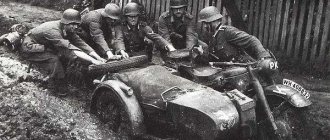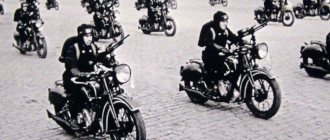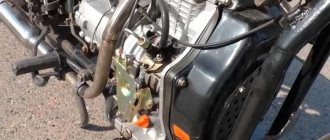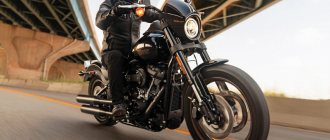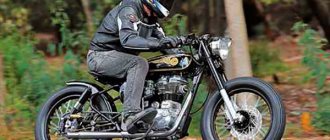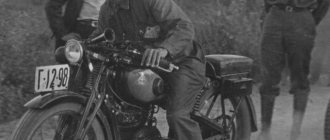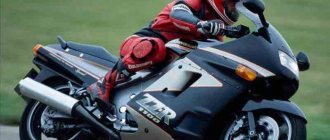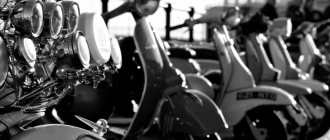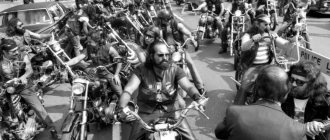Nowadays, few people know about the Zundapp company. The name of the once famous manufacturer is almost forgotten. However, in certain circles the Tsundap motorcycle is still considered a legend. Most lovers of history and good motorcycle technology can only dream of acquiring it.
Our article, dedicated to one of the most famous Wehrmacht transport models, will help fill this gap.
How it all began
Exactly one hundred years ago a manufacturing company opened in Germany. The owners planned to start manufacturing fuses, shells and spare parts for them, which was especially important in those days. The production was initially planned to be quite large. But all preparatory and organizational work was completed exactly by the end of the war. It is clear that the demand for ammunition was falling at a catastrophic rate, so there was a need to immediately reorient production capacity to meet peacetime needs.
Kattenkrad aka Sd. Kfz. 2
The tip of the iceberg among high-torque motorcycles. Kattenkrad - a tracked motorcycle with a one and a half liter Opel engine replaced the main horse-drawn force, dragging heavy guns and even airplanes. The most heavy-duty type of motorized transport in the enemy army. The obvious disadvantages of this development were difficulties in passing diagonally on a hill, an extremely uncomfortable landing and seat height, due to which the pilot had difficulty leaving his seat in case of trouble. And the Kattenkrad turned over quite often, especially on sharp and sharp turns.
First models
The owners decided to start producing vehicles. The first motorcycle, the Tsundap Z22, was introduced in 1921. It was quite in keeping with the spirit of the times. From a technical point of view, the motorcycle did not shine with anything special, but it was capable of accelerating to 65 km/h, while consuming less than a liter of gasoline. What else do you need in a crisis? Soon the line was replenished with the Z2G model, which has slight differences from the prototype.
Since 1924, the company began producing motorcycles with a chain drive (before that there was a belt drive), and in 1927, cargo trikes were added to the line. Even with the onset of the Great Depression, which undoubtedly affected the German economy, the manufacturer developed new models, introduced innovations, increased production capacity and remained afloat. A significant role was played by the company's policy aimed at constantly improving the reliability of manufactured vehicles. At the same time, Tsundap has always tried to maintain a loyal price level.
Competent management, constant market analysis, and focus on consumer demand also contributed to success. For example, as a result of the crisis, a new product appeared in the Tsundap line - the K170 motorcycle, the smallest and most economical in the entire history of the company. Along with its production, a project was launched to produce large, heavy bikes with four-stroke engines. To achieve this, the company signed a cooperation agreement with English colleagues. The result was the release of several models with Python engines.
DKW
0
0
0
By 1944, Germany began to use lighter motorcycles more. The most popular were DKW RT125 and DKW NZ350. The 123cc two-stroke DKW RT125 was introduced into service in 1941 and became a masterpiece of engineering. In 1943, a militarized version of the motorcycle was released with a more capacious tank and crankcase cast from cast iron. The engine produced 6.4 hp. and accelerated the motorcycle to 75 km/h. The DKW NZ350 was produced only for the army. Thanks to the low gear ratios of the gearbox, it easily walked through the mud at low speeds. With a weight of 145 kg and a power of 11.5 liters. With. the motorcycle reached a speed of 105 km/h. Both models were produced until the end of the war and were so successful that their clones were distributed throughout the world. Based on the DKW RT125, the Minsk, M1A Moscow and K-125 were developed in the USSR, and the DKW NZ350 became the prototype of the IZH-350.
Motorcycle "Tsundap" on the fronts of World War II
1937 was a turning point in the history of the company. During World War II, the Zundap motorcycle with a sidecar was in service with the Wehrmacht troops.
It is worth noting that the idea of using light two- and three-wheeled vehicles to increase the mobility of troops was quite interesting. A machine gun mounted on the hood of the stroller was supposed to cause damage to the enemy. The motorcycle could go where a car simply wouldn’t turn around, and the costs of its maintenance and service were disproportionately lower.
The KS 600 model, equipped with a driveshaft, interchangeable wheels and a 598 cc boxer engine, was released in 1939. This motorcycle has been on almost all fronts in Europe. Having successfully passed the fire test, it underwent some modifications and improvements. As a result, a new vehicle appeared - the German motorcycle "Zundap" KS 750. It was immediately sent to the front line.
This motorcycle also reached Russia. But it is not in vain that legends, sayings and poems are written about our roads. Everything that has already happened in Europe has choked in the Russian mud. It was simply unrealistic to conduct targeted machine-gun fire from a heavy motorcycle galloping over potholes. But the crew became easy prey for Russian soldiers with three-rulers. The idea of using motorized vehicles in military operations has been revised. Of course, there was no talk of a complete withdrawal, but in Russian realities, motorcycles designed for European roads were more often used for security and supply tasks. Direct use in combat has been significantly reduced.
During the war years, the manufacturer made several improvements to his brainchild. In particular, a front wheel drive was developed for the model with a sidecar. By 1945, the share of the KS 750 even exceeded the R75 (BMW).
NSU "Kettenkrad"
0
0
0
0
This caterpillar motorcycle went down in history under the name "Kettenkrad" (Kettenkrad - truck, "Kraftrad" - motorcycle), was developed by the inventor Heinrich Ernst Kniepkamp and was produced equipped with a 1.5-liter Opel Olimpia engine with a power of 36 hp. With. The motor tractor reached a speed of 65 km/h on the highway and up to 40 km/h on rough terrain. Initially developed for landing forces operating behind enemy lines, but later began to serve as a tractor. It could pull an artillery piece weighing up to half a ton, or a trailer. I was engaged in towing aircraft at airfields, laying communication lines - a reel of wire could easily fit behind it. After the war, surviving specimens were used in agriculture. A total of 9 thousand copies were produced from 1940 to 1949.
Demand and prices
Today there are many who dream of buying a Tsundap motorcycle, the price of which is not determined by its technical characteristics. A legendary bike with an excellent design even by today’s standards is a rarity. The number of working copies worldwide does not exceed several hundred. You can see one of them at historical reconstructions, in a club for fans of retro technology, or in a museum. The cost of a motorcycle starts at 50 thousand dollars.
BMW R75
0
×
0
0
The BMW motorcycle became widespread in the Wehrmacht army. This happened thanks to the R12 and R71 models. But the most famous motorcycle of World War II was the BMW R75, nicknamed “Sahara” due to the fact that it was supplied to Rommel’s army in Africa. The off-road motorcycle had a four-stroke boxer engine with a volume of 745 cm3 and a power of 26 hp. s., cardan, hydraulic rear brake and nine speeds: seven forward and two reverse. A motorcyclist could stop on the Sahara in the middle of a swamp or sand and move off without slipping. The downside to the R75's excellence was its price. The motorcycle cost the price of two Volkswagen cars. The BMW R75 could tow a 37 mm PaK-35/36 anti-tank gun or a trailer with an 81 mm mortar or anti-tank rifle. MG-34 and MG-42 machine guns or a flamethrower were installed on the stroller. On the sidecar and on the motorcycle there were brackets for containers with ammunition, canisters and camouflage nets. The motorcycle was used in reconnaissance units, in motorcycle rifle units and became one of the symbols of fascist aggression.
History of the Zundapp brand The Zundapp company (Zundapp or Zundapp in Russian transcription) is completely forgotten these days. Meanwhile, 60 years ago it was one of the largest motorcycle manufacturers in Germany, and its products were no less popular than BMW motorcycles. Today this name is known only to fans of rare motorcycles and, perhaps, to those who are deeply interested in weapons and transport of the times Second World War. The company appeared in 1917 (the name comes from “Zünden und Apparaten Bau” - “Manufacture of ignition devices and equipment”) and intended to produce fuses. For this purpose, a huge plant was built, which was launched at the wrong time - just in time for the end of the war. For obvious reasons, the demand for grenades and shells has fallen sharply. It was decided to take up motorcycles. The English “Lewis” was taken as a model. The debut took place in 1921 and was called Zundapp Z22. The machine weighed 60 kg, had a single-cylinder two-stroke engine with a displacement of 211 cm3 (62x70 mm) with a cast iron cylinder and piston, a separate lubrication system (the mechanism, using a small pump, sprayed oil into the engine from time to time) with a power of 2.25 hp, was positioned as “a motorcycle for everyone”, i.e. cheap and cheerful.
{nomultithumb}
The engine was very simple, had a simple carburetor and a magneto ignition system. A large external flywheel transmitted torque to the wheel using a belt. The fuel tank, located in the camber of the frame, was divided into two parts. The front one was used to store oil. The rear wheel was rigidly suspended, but the front fork was equipped with shock absorbers, which were just beginning to be widely used in motorcycles. The Germans confirmed their advertising slogan: it turned out to be cheap - a record race in Berlin showed fuel consumption of 0.75 liters per hundred, and angrily - the car proved this during runs in Europe and Africa, accelerating up to 65 km/h! The model was a success (1,500 copies by 1922 and 5,000 in plans for the future), but, of course, not because of its decisive technical superiority over its competitors. The Z22 and Z2G models (mostly analogue, but with a dual-range transmission that allowed more flexible use of the engine's capabilities) won various competitions, often of local significance.
The Z22 and Z2G models were built from 1921 to 1924 and from 1922 to 1924, respectively. In 1923-1924, the Z249 model was produced, which was essentially a Z2G with a cubic capacity increased to 249 cm. (62x82.5 mm) cylinder volume. The first really serious change occurred in 1924 with the release of the K 249 model, where “K” stands for “Kette” - chain. This model was equipped with a three-speed gearbox and had a chain wheel drive. There was also a drum brake on the rear wheel. The front fork is similar in design, but the angle of inclination has become sharper. The shape of the steering wheel has also changed slightly. The tank line along the top tube of the frame gave it a sportier look. In early 1924, the company commissioned its first modern assembly line. By the end of the year, more than 10 thousand cars were assembled on its assembly line.
In 1925, a new model appeared, which the plant presents as the first step towards creating an absolutely reliable and unpretentious motorcycle. The motto means “Motorcycles we can count on.” The name of the new motorcycle is EM250, where EM stands for “Eingeitsmodell” - the standard model. The name itself suggests constancy and inviolability, but production lasted only three years in two versions 250 and 300 cc. About 28,000 EM series motorcycles were produced.
In 1927, cargo trikes appeared.
In 1928, after tax exemption for cars with an engine capacity of less than 200 cm3. The plant, which did not have such a motorcycle in its model range, developed and offered its customers the Z200 model, a classic one, but at the same time, which was the first for Zündapp to have an alloy piston. Just like the Z300 that immediately followed, the Z200 can offer the buyer a choice of two types of fuel tanks. 1929 is the year of the Great Depression in the USA. The crisis did not spare Germany either. Despite this, the plant produces 25,000 units of motorcycles, invests in the construction of a new production facility in Nuremberg and takes a leading position in the field of technological progress. But, despite this, production fell and in 1931 losses amounted to about a quarter of the 1929 level.
In order to limit the consequences of the crisis, more affordable S series motorcycles were developed: S200, S300, S350. These machines used frames similar to the EM series, i.e., made of steel profiles. The engines were single-cylinder two-stroke, using some improvements that were more of a commercial rather than technical nature. However, they were quite effective, which allowed the S350 with its 11 hp. s., reach a speed of up to 100 km/h.
The crisis also contributed to the appearance in 1932 of the smallest model at that time, the B170. But in parallel, work was carried out on the design of large models with four-stroke engines. Since the company had so far designed only two-stroke engines, it was decided to turn to specialists in four-stroke engines from the English company Python (supplied to the motor market under the Rudge brand). These engines developed 18 hp. With. for the Tourism version (S500) and 22 l. With. for the “Sport” version (SS500). The period of use of Python engines was very short. At the 1933 Berlin Motor Show, Zündapp presented the K400, K500, K600 and K800 models with engines of his own design. The K400 and K500 had two-cylinder opposed four-stroke engines, while the K600 and K800 had four-cylinder engines. The engines are very powerful and reliable, equipped with a new four-speed gearbox for Zündapp, mounted in one unit with the engine. The drive to the rear wheel of motorcycles was carried out through a shaft and bevel gears, which, although expensive, was reliable.
Technically and aesthetically, Zundapp products were similar to BMW products. Externally, they differ greatly in the front fork: BMW uses a package of springs, while Zündapp built a parallelogram fork with a single large spring and a hydraulic shock absorber on some models. The connection with the past was not broken either - two models also appeared with small engines: the Derby 175 - a legacy of the previous period, and the K200, which had a K-series chassis and transmission. The plant left the K400 and K600 in the production line for only one year, while the K500 and K800 were produced until 1938 and 1940. respectively.
In 1935, the single-cylinder (Derby) received a new engine with a three-channel scavenging volume of 200 cm3. and a lighter tubular frame, became the progenitor of a whole series of different motorcycles (DB175, DE200, DL200, DK200, DB200, DBK200). Derby was continued in 1937, when the DB250 was created and released to the external, and only then to the domestic market, and a little later, in 1938, the DBK250. The DS350 (Zundapp's first foot-shift motorcycle) with a single-cylinder, four-stroke engine was produced from 1937 to 1940. and occupied a small niche in the company's product line, since its engine emerged as a result of Zündapp's research in the field of aircraft engines. In the K series in 1935-1936. K350 was produced, later, in 1936-1937. after a slight modernization, it received the KK index (lightweight). The KS500 model was equipped with a two-cylinder boxer engine developing 24 hp. With. at 5200 rpm. When the engine was installed on a lightweight chassis, the model received the KKS500 index. KS600 was developed specifically for use with a stroller. Engine similar to KS500 due to the extra 100 cc. I bought another 4 liters. With. It developed maximum power at 4700 rpm. KS600 was produced until 1941, production was restored after the war in 1949-1950.
Starting in 1937, Zündapp began fruitful cooperation with the military and the company became a supplier to the Reichswehr, and then the Wehrmacht. Like the BMW R12, K500, K800, KS600 are becoming the main equipment of the army. All these models were, in fact, single models, allowing them to be used with a side trailer. At the same time, work was carried out on a model intended for use only with a stroller. By March 1941, the KS750 was created, which had a drive and a sidecar wheel, equipped with a differential, and a four-speed gearbox with reverse gear. The KS750 was even more common than the BMW R75. Zündapp delivered 18,200 KS750 units to the troops, versus 16,500 R75. Production of the KS750 continued until 1945.
During the war, the enterprise suffered greatly - bombing took its toll, the plant was left unguarded several times and, of course, was robbed. In order to somehow stay afloat, the company dealt with various small things; also about 600 engines were used for the production of generators. Since 1947, production of the pre-war DB200 was resumed, continuing until 1951. In 1949, the Zündapp KS601 appeared, equipped with a two-cylinder four-stroke boxer engine with a displacement of 596 cc. cm and power 28 hp. The maximum speed of the device was 140 km/h. In 1950, motorcycles received telescopic front forks and spark plug rear suspension, and in 1953 a new family of motorcycles called Elastic appeared. Motorcycles in this series had two-stroke engines with a volume of 198 and 246 cm3. In the same year, they began producing Combinette series mopeds and Bella scooters. But the development of motor scooters also had a negative side - the production of motorcycles was falling. In addition, heavy motorcycles were being replaced by cabin roller cars.
The post-war German economy gradually came to its senses, and the population had more free money. By March 1957, Zündapp launched Janus on the market. Motorized stroller with a single-cylinder two-stroke motorcycle engine with a volume of 250 cm3 and a power of 14 hp. With. at 5000 rpm, located in the center of the wheelbase. Due to such an unusual layout, the second row of seats was located with its back to the first. The driver and passengers of the first and second row entered through two identical doors at the front and rear of the car. Thanks to this, it was possible to create continuous side glazing. Janus was not very successful due to the noise of the engine in the cabin. 6,900 copies were collected and in 1958 the production of Januses was curtailed.
As a result, by the beginning of the sixties, Zundapp turned out to be one of the largest manufacturers of motorcycles in Germany. A wide range of devices were produced - mopeds and mokicks, Trophy motorcycles, Bella scooters, produced until 1963-64. KS601 was also removed even earlier. In the middle of the decade, new, modern, lightweight motorcycles replaced the old models. The first was the Zundapp KS 50, which debuted in 1961. “Baby” showed its agility and endurance during tests at the Monza circuit, where it drove continuously for 144 hours for 10,600 kilometers at an average speed of 70.24 km/h! In the following decades, the company slowly declined despite the fact that modifications of the KS50 were developed - KS50 Super and KS50 Sport, and motorcycles were produced covering all classes up to 175 cc. In 1972-1976. There was even a cross-country modification of the KS50, but its off-road qualities were poorly implemented.
In 1963, a 98-cc analogue of the KS 50 appeared. In 1970, the Zundapp KS 125 appeared, having a tubular duplex frame and an engine with a power of as much as 15 hp. In 1972, a new model appeared, which was clearly ahead of its time and therefore not entirely successful from a commercial point of view: Mokiki with a 500-watt electric motor. In the same year, the company began production of the Zundapp KSSOWC “fifty-kopeck” liquid-cooled motorcycle! In 1976, the Zundapp KS 175 appeared, equipped with a 163 cc engine. cm and power 17 hp. with liquid cooling, front wheel disc brake and alloy wheels. The car weighed 120 kg and accelerated to 130 mph. In the same year, the 350 cc was introduced. prototype with liquid cooling, 6-speed gearbox, which had a power of 27 hp. With. The trouble is that he had to compete with the Japanese motorcycles Kawasaki KH250, Suzuki GT Ram Air, Yamaha RD 350, which had already taken a strong position in the market. The Germans offered a ready-made motorcycle only by 1978. An excellently functioning enterprise, a firmly occupied niche in the market, modern production - what could threaten such a rapidly developing Japanese motorcycle industry, sweeping away many other brands, killed Zundapp. In 1984, the Zundapp team won the world road racing championship. A nice gesture before leaving the stage.

